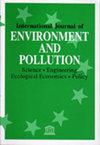纳米技术用于生物修复的当前趋势
IF 0.3
4区 环境科学与生态学
Q4 ENVIRONMENTAL SCIENCES
International Journal of Environment and Pollution
Pub Date : 2019-01-01
DOI:10.1504/IJEP.2020.10023170
引用次数: 11
摘要
纳米技术是一个新兴的领域,它生产的纳米级产品具有更有效的反应性和比其本体相更大的表面积。纳米粒子的这些独特属性为它们在清理石油碳氢化合物、杀虫剂和金属污染场所方面的应用提供了巨大的潜力。与传统的物理化学修复方法相比,生物修复因其经济、环保和自推进的特点而越来越受到人们的重视。纳米粒子(NPs)可以通过吸附或化学改性直接用于去除有机污染物。它们还可以通过固定或诱导产生修复微生物酶来促进微生物对污染物的修复。本文综述了不同类型的纳米技术与生物和植物为基础的生物修复方法。本文章由计算机程序翻译,如有差异,请以英文原文为准。
Current trends in nanotechnology for bioremediation
Nanotechnology is an emerging field to produce nano-scale products with more efficient reactivity and larger surface area than its bulk phase. These unique attributes of nanoparticles offer immense potential for their application to clean up petroleum hydrocarbons, pesticides, and metal-contaminated sites. As compared to the conventional physicochemical methods of remediation of contaminated sites, the bioremediation has been drawing increasing attention due to its economic, eco-friendly and self-propelling attributes. Nanoparticles (NPs) can be either applied directly for removal of organic contaminants through adsorption or chemical modification. They can also serve as a facilitator in microbial remediation of contaminants either by immobilising or through the induced production of remediating microbial enzymes. The present review provides an overview of different types of nano-technologies with biological and plant-based bioremediation approaches.
求助全文
通过发布文献求助,成功后即可免费获取论文全文。
去求助
来源期刊
CiteScore
1.10
自引率
0.00%
发文量
3
审稿时长
4.5 months
期刊介绍:
IJEP provides an international forum in the field of environment and pollution and addresses early and medium-term challenges involving scientific prediction, modelling and assessment. It focuses on ground-breaking research in the science of environmental pollution, at the early scientific stage. It is one of three key journals which together offer complete coverage of environmental issues: IJETM focuses on technical/engineering, policy and management solutions for environmental problems, and IJGEnvI focuses on future, longer-term environmental scenarios, ecological economics, climate change and biodiversity.

 求助内容:
求助内容: 应助结果提醒方式:
应助结果提醒方式:


